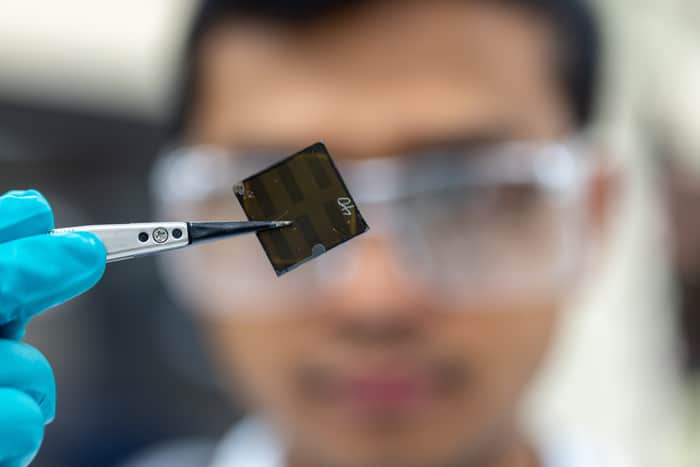
A solar cell that incorporates both three-dimensional and two-dimensional forms of perovskite crystals retains its efficiency even after exposure to high heat and humidity – a first for a device made from this promising yet notoriously unstable photovoltaic material. The device, which was developed by researchers in Saudi Arabia, preserves 95% of its initial efficiency after enduring 1000 hours at 85°C temperatures and an 85% relative humidity, thereby meeting a critical industrial stability standard for photovoltaic modules.
Perovskites are crystalline materials with an ABX3 structure, where A is caesium, methylammonium (MA) or formamidinium (FA); B is lead or tin; and X is chlorine, bromine or iodine. They are promising candidates for thin-film solar cells because they can absorb light over a broad range of solar spectrum wavelengths thanks to their tuneable bandgaps. Charge carriers (electrons and holes) can also diffuse through them quickly and over long distances. These properties give perovskite solar cells a power conversion efficiency (PCE) of more than 18%, placing their performance on a par with established solar-cell materials such as silicon, gallium arsenide and cadmium telluride.
The problem is that perovskites suffer from naturally-occurring surface defects and are prone to structural changes known as ion migration. Both factors tend to make perovskite films unstable, and these instabilities becomes even more pronounced with higher temperatures and exposure to water molecules.
More robust to heat and humidity
In the new work, a team of researchers led by Stefaan De Wolf at the King Abdullah University of Science and Technology (KAUST) made a semiconductor heterojunction by sandwiching a photosensitive 3D perovskite, which converts light to electricity by creating pairs of charge carriers, between two 2D perovskite layers (one n-type and one p-type). The electrons and holes then separate, with the electrons migrating towards the n-type 2D perovskite layers and the holes migrating towards the p-type layers, thus generating an electric current.
As 2D perovskites are more robust to heat and humidity than 3D perovskites, growing a layer of the former on a film of the latter produces a heterojunction that can block migrating ions as well as moisture. With the 2D layers essentially forming a passivating “top coat” for the 3D film, the KAUST team’s solar cell boasted a power conversion of 24.7% and an open-circuit voltage of around 1.20 eV.

In search of new solutions for cheap and stable solar cells
The researchers also discovered that tailoring the number of 2D sheets (or their dimensionality) was important for effective top-coat passivation. This technique has been employed before to improve the performance and stability of conventional solar cells in which the p-type layer is at the top. Until now, however, it had not worked for inverted devices in which the n-type layer is at the top.
The team, which reports its work in Science, says its members are now designing new molecules for 2D perovskites to develop ultrastable inverted perovskite cells with efficiencies close to those of regular devices, which can exceed 25%. “We will also be performing other IEC [industrial standard] stability tests, including the effects of reverse voltage biasing and testing the devices outdoors to understand – and address – stability-limiting factors,” De Wolf tells Physics World. “We also aim to integrate the developed 2D/3D heterojunctions in other perovskite-based solar cells such as ‘tandem devices’.”
